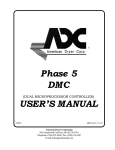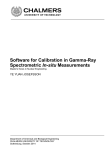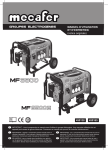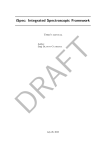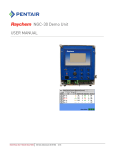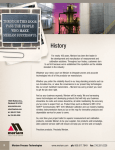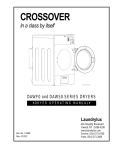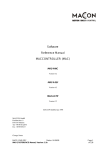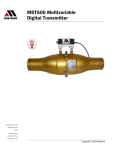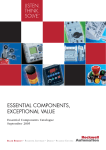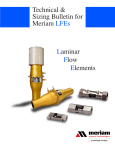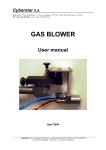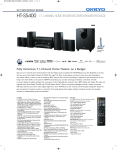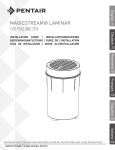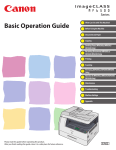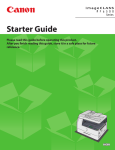Download User`s Manual Laminar Flow Elements
Transcript
501:440-13 User’s Manual Laminar Flow Elements 10920 Madison Avenue Cleveland, Ohio 44102▪Tel: 216.281.1100▪email:[email protected]▪Web:www.meriam.com 1 TABLE OF CONTENTS Subject Page Introduction ................................................................................................................................................................ 3 Inspection ................................................................................................................................................................... 3 Installation .................................................................................................................................................................. 3 Operation .................................................................................................................................................................... 4 Typical Installations ................................................................................................................................................... 4 Calibration Curve/Table ............................................................................................................................................. 5 Actual Standard and Mass Flow Equations ........................................................................................................... 5-7 Reading your Laminar Flow Element Curve/Table .................................................................................................... 9 Correction Factor Tables/Curves Air Humidity for Density ...................................................................................................................................... 8 Air Humidity for Viscosity .................................................................................................................................... 8 Pressure ............................................................................................................................................................... 12 Air Viscosity........................................................................................................................................................ 13 Air Temperature/Viscosity .................................................................................................................................. 14 Temperature......................................................................................................................................................... 15 Maintenance ............................................................................................................................................................ 14 Troubleshooting....................................................................................................................................................... 15 LFE Dimensions ..................................................................................................................................................... 17 2 Introduction Because of their inherently high accuracy, stable calibration, excellent response time and repeatability, Laminar Flow Elements (LFEs) excel in critical gas and air flow measurements and are frequently utilized in validating calibration standards. Standard models are available to measure as little as 0.2 SCCM (5.9 E-06 SCFM) to as much as 2250 SCFM at standard conditions. Custom models for up to 15,000 SCFM of air are available. Stainless steel or aluminum materials make LFEs compatible with most gases and flow rate of gas mixtures can also be measured when the percentages of component gases and mixture properties are known. Higher accuracies can be achieved when used in conjunction with the Meriam MDT500 multivariable transmitter and software package. The LFE matrix is made from individual SS tubes or windings of SS foil, these tubes are long enough, relative to their inside diameter to cause laminar flow to occur inside each tube, the result is a near linear relationship between DP and flow rate. The DP generated across the matrix responds very quickly to changes in flow and pressure loss to the system is reduced as each LFE is sized to produce no greater than 8” water column at maximum flowing conditions. Individual tube diameters are very small so flowing gases need to be clean and dry to preserve the calibration. Filtered inlet versions of most LFE models are available to keep the matrix clean and the calibration constant. This manual covers models 50MK10, 50MW20, 50MR2, 50MJ10, 50MC2 and 50MY15. For descriptions, dimensions and capacities of these elements refer to Meriam Bulletin, File No. 501:215 Special Precautions When Handling Matrix Elements The Meriam LFE depends on the precise fabrication of a matrix metering element for its basic accuracy. These elements are manufactured from .001 inch stainless steel stock and are carefully fabricated. Exercise extreme care when handling the exposed element to make sure the end faces are not gouged or damaged in any fashion. Gouges or damage to the end surfaces may produce nonlinear resistance to flow and introduce error. If the end surface becomes damaged, the accuracy of the element may be restored by recalibration at the factory. Inspection 1. Make sure you have unpacked all instructions and other data that accompanied the unit. 2. Visually inspect for any signs of damage. There must be no nicks or scratches, surfaces of the LFE should be clear. 3. Units are shipped with a cap plug in each opening which protects the ends and pressure taps. Remove these cap plugs. 4. Visually inspect matrix surface and inside housing. No capillaries should be blocked unless specified in special applications. Installation Make sure the line is free of dirt and other foreign materials. The metered gas must be clean. In-line use of filters is recommended. Connections to the differential pressure instrument should be made with equal lengths of 1/4" I.D hose, tubing or pipe. All instrument connections must be leak- free. Install temperature sensor 2-diameters upstream of the element. Inlet absolute pressure instrument, when needed, must be connected close to the LFE at the inlet pressure tap. Figure 1 shows several typical LFE installations. Install the LFE in the line using hose connectors, flanges, tubing or pipe, as desired. Position the LFE in any orientation. Horizontal is the most common. Orient the high-pressure and low-pressure sensing ports in any angular direction. Flow must be in the direction of the arrow on the LFE. Avoid disturbances upstream of the LFE. Good measurement practices dictate an adequate straight run of the pipe up and downstream of the element. In most installations, 10 diameters upstream and 5 diameters downstream are adequate. Where installation makes straight pipe runs impossible, LFE's can be calibrated with piping configurations that duplicate installation. This special calibration assures installed accuracy. In these applications, consult Meriam regarding calibration. 3 Operation Establish flow through the LFE. Measure t h e differential pressure between high pressure sensing port and low pressure sensing port. Measure the inlet gas temperature. For standard or mass flow rates, measure absolute line pressure. Refer to calibration curve/table instructions for flow rate calculations. Standard or Mass Flow Rate Actual Volumetric Flow Rate 4 Laminar Flow Systems or MDT 500 Figure1: Typical Installations of Laminar Flow Elements Actual, Standard, or Mass Flow Calibration Curve Table Meriam performs an air calibration of the LFE using a master flowmeter that is traceable to the National Standards and Technology (NIST). The calibration data is standardized to an equivalent dry gas flow rate at 70ºF (21.1ºC) and 29.92 inches Hg absolute (101.3 kPa abs.). (The customer may request another standard condition such as OºC.) It is then possible to determine the actual or standard volumetric flow rate at your flowing conditions. Each LFE has at least one calibration curve or table. The standard curve/table is for dry air flow rate in units of cubic feet per minute (CFM) versus the differential pressure (DP) in inches of water referenced to 4ºC produced by the LFE. You may request a curve/table for a different gas and/or for different flow rate units. Each curve/ table is generated using a quadratic (second order) equation. B x DP + C x DP² = Flow The calibration constants B and C are printed on each curve/table. Actual Volumetric Flow Rate The LFE determines the actual volumetric flow rate. To obtain the actual volumetric flow rate, the differential pressure across the LFE and the inlet temperature to the LFE is measured. Using the calibration curve/table associated with the particular LFE; a flow rate value is obtained by either 1) reading the value from the curve/table or: 2) using the formula, B x DP + C x DP² = Flow Each curve has unique constants B and C. Multiply this flow rate value by the ratio: (viscosityofflowinggasat70°Finmicropoise) (viscosityofflowinggasatflowingtemperatureinmicropoise) or μstd / µf. The product is the actual volumetric flow rate. (The curve/table lists the type of gas used to generate the curve/table.) Actual volumetric flow rate= (B x DP +C x DP²) x ( μstd μf) 5 To help calculate the viscosity of air at flowing temperature, a viscosity equation based on temperature is included in this instruction manual (see Table A-32422). The equation is from “tables of Thermodynamic and transport Properties of Air, Argon, Carbon Dioxide, Oxygen, and Steam.” All other gas viscosity equations are obtained from "Physical and Thermodynamic Properties of Pure Chemicals" Table A-31986 lists the values of μstd / µf for air from 50-159ºF at 1º intervals when the standard temperature is 70°F. *Note: If you are flowing wet air, a humidity correction factor for viscosity must be used. The difference between wet-air viscosity (µwet and dry-air viscosity (µdry) increases with temperature and humidity, at 80ºF and 80% relative humidity, the ratio of µwet / µdry is .997. Figure 2 is a graph of the ratio µwet / µdry of air from 50 to 150ºF and from 10 to 90% relative humidity. The viscosity of the flowing wet air becomes the value from the dry-air viscosity equation times the ratio µwet / µdry µf = µwet air = Where T = ºK )*+, 14.58+($)32 ' x ( )-./ 0 (110.4+$) The curve/table may have DP units of 1) inches of water column (WC) 2) centimeters of WC 3) millimeters of WC 4) pascals 5) kilopascals Whenever a pressure is expressed in units of water, the water temperature reference must be given. The calibration curve uses 4°C for the water temperature reference. Some devices use a water temperature reference of 20ºC and others may use other temperature references. If no temperature reference is given on the DP instrument or in its instruction manual, consult the manufacturer. If the DP measuring device has a water temperature reference other than 4º, correct the DP reading by using the following equation: DP @ 4ºC = DP (device) x -+123,/45678@,+:;+.<,=.+,+:;+.<,=.+.+5. -+123,/45678@>°? Water Temperature 4.0°C (39.2°F) 20.0°C (68.0°F) 15.5°C (60.0°F) 21.1°C (70.0°F) Water Density (lbs/ft³) 62.426 62.316 62.366 62.301 The DP @ 4ºC value should be used with the curve/table. Standard Volumetric Flow Rate The word "standard" when associated with flow rate, means the flow rate has been normalized to an assigned standard pressure and temperature. If standard volumetric flow rate is desired, the actual volumetric flow rate is multiplied by the ratios. @,<1-<.-,+:;+.<,=.+(A2,-) 5B4*31C,+:;+.<,=.+(A5) and 5B4*31C;.+22=.+(D5) 2,<1-<.-;.+22=.+(D2,-) 6 Be sure to use the same absolute units for pressure (i.e. PSIA, mm Hg absolute,...) and temperature (ºK or ºR). The result is the standard volumetric flow rate at the given standard conditions. Standard volumetric flow rate = Actual volumetric flow rate x ( )2,- ( This equation can be rewritten: (B x DP + C x DP²) x A2,- A2,- 0x( )5 D5 0 x (D2,-0 A5 A5 D5 0 x (D2,-0 Table A-31031 lists the values of Pf/Pstd absolute line pressures from 26”Hg at 0.05” Hg intervals. The standard pressure is 29.92” Hg absolute for this table. Table A-32422 lists the values of (Tstd / Tf) x (µstd / µf) for air from 50 to 159ºF in 1º intervals. The standard temperature is 70ºF (529.67ºR) for this table. Note: If you are flowing wet air, a humidity correction factor for standard volumetric flow rate must be used. The difference between wet-air density (Pwet) and dry-air density (Pdry) increases with temperature and humidity. At 80°F and 80% relative humidity, the ratio of Pwet / Pdry is .990. Table A-35600 lists the ratio Pwet / Pdry of air from 40 to 100°F and from 20 to 100% relative humidity. The equation for standard volumetric flow rate of flowing wet air becomes: Standard Volumetric Flow Rate Wet Air = (B x DP + C x DP²) x ( )2,- 0x( )*+,<3. A2,A5 D5 D*+, 0 x (D2,-0 x ( D-./ 0 Mass Flow Rate Multiply the standard volumetric flow rate by the density of the flowing gas at standard conditions to obtain the mass flow rate of that gas. Mass Flow rate = Standard volumetric flow rate x density @ standard conditions Summary Curve/table value @ DP = (B x DP + C x DP²) )2,- Actual volumetric flow rate = (B x DP + C x DP²) x ( )5 0 Standard volumetric flow rate = Actual volumetric flow rate x ( D5 D2,- 0x( EFGH EI 0 Mass flow rate = Standard volumetric flow rate x density @ standard conditions 7 Temperature oF Air Viscosity Correction Factor for Humidity, Uwet/Udry 50 60 70 80 90 100 110 120 130 140 150 1 10% Humidity 20% Humidity 0.99 30% Humidity 40% Humidity 0.98 50% Humidity 60% Humidity 70% Humidity 0.97 80% Humidity 90% Humidity 0.96 Figure2: Relative humidity correction factor for air viscosity. A-35500 Kestin & Whitelaw Table A-35600 (NBSIR 83-2652) Humidity Correction Factor for Air = Pwet / Pdry % Relative Humidity °F 20% 40% 60% 80% 100% 40 .9993 .9987 .9981 .9975 .9969 50 .9990 .9981 .9973 .9964 .9955 60 .9986 .9973 .9960 .9948 .9934 70 .9981 .9962 .9944 .9925 .9907 80 .9974 .9948 .9922 .9895 .9870 90 .9964 .9928 .9892 .9855 .9818 100 .9951 .9902 .9854 .9805 .9756 8 Determining Flow from your Laminar Flow Element Calibration Curve/Table The curve/table of each LFE is normalized to standard conditions listed by multiplying the calibration data points by the ratio of: J32K423,/45C<2<,K<B3L.<,341,+:;+.<,=.+ J32K423,/45C<2<,MN°O(2,<1-<.-,+:;+.<,=.+) Therefore, you should NOT read the flow rate directly from the curve/table unless your flow temperature and pressure are identical to the standard conditions. The following steps must be taken to determine flow rate at flowing conditions other than standard. 1. Measure and correct to 4ºC and if necessary, the DP across the LFE. 2. Measure and record the inlet temperature (always) and absolute line pressure (for s tandard or mass flow rates). Convert both values to absolute units. 3. Follow the AIR FLOW or GAS OTHER THAN AIR guidelines below Model 50MK10 All Other Models 5 6 7 8 Flow, Q 0 1 2 3 Flow, Q Flow, Q 4 0 4 1 2 3 4 Differential Pressure, Inch of Water @ 4ºC Differential Pressure, Inch of Water @ 4ºC Air Flow Select the proper flow curve/table for the LFE being used. Standard Volumetric Flow Rate 1) To obtain standard volumetric flow rate if inlet pressure and temperature are other than 29.92" Hg absolute and 70ºF, respectively, find the flow rate (Q) that corresponds to the corrected DP. Multiply Q by temperature/viscosity and pressure corrections shown on charts A-32422 and A-31031, respectively, to bring flow to standard conditions of 29.92" Hg and 70ºF. 2) At flowing conditions of 70'F and 29.92" Hg, read curve directly in standard volumetric flow rate. 9 Actual Volumetric Flow Rate 1) To obtain actual volumetric flow rate at inlet flowing temperature other than 70ºF, find the flow rate (Q) that corresponds to the corrected DP. Multiply Q by the viscosity correction only. See chart A-31986 for corrections. 2) At flowing inlet temperature of 70ºF read curve directly in actual volumetric flow rate. Actual volumetric flow rate equals standard volumetric flow rate when flowing conditions are 70ºF and 29.92" Hg. Notify Meriam if your flowing gas is not air and/or standard conditions are different from 70ºF and 29.92" Hg absolute. A special curve/table can be provided listing the gas being flowed. The gas viscosity correction, µstd / µf will reference the gas and/or new standard temperature value, if applicable. Table A-32422 or A-31986 cannot be used for gases other than air. Gas Flow Other Than Air/Standard Conditions From 70°F and 29.92” Hg ABS. Select the proper flow curve/table for the LFE being used. Standard Volumetric Flow Rate 1) To obtain standard volumetric flow rate if the inlet temperature and pressure are different from standard, read the flow rate (Q) from the curve/table corresponding to the corrected differential pressure (DP). Calculate the viscosity at the flowing temperature using the viscosity equation for the flowing gas. Then calculate the viscosity correction factor (µcf) using µcf = P32K423,/K412,<1,5.4:K=.J+/,<LB+ 5B4*31CC<2J32K423,/<,5B4*31C,+:;+.<,=.+ Locate the pressure correction factor (Pcf) for the flowing inlet pressure on chart A-31031 or calculate the correction factor using Pcf = <L24B=,+31B+,B31+;.+22=.+ <L24B=,+2,<1-<.-;.+22=.+ Locate the temperature correction factor (Tcf) for the flowing temperature on chart A-35700 or calculate using Tcf = <L24B=,+2,<1-<.-,+:;+.<,=.+ <L24B=,+5B4*31C,+:;+.<,=.+ Multiply Q from the curve/table by the viscosity correction factor (µcf), the pressure correction factor (Pcf) and the temperature correction factor (Tcf). This product will give the flow rate of a particular gas at the standard conditions. 2) At flowing inlet conditions equal to the standard conditions, read curve/table directly in standard volumetric flow rate. 10 Actual Volumetric Flow Rate 1) To obtain actual volumetric flow rate if the inlet temperature is different from standard temperature, read the flow rate (Q) from the curve corresponding to the corrected DP. Calculate the viscosity at the flowing temperature using the viscosity equation for the flowing gas. Then calculate the viscosity correction factor using µcf = J32K423,/K412,<1,5.4:K=.J+/,<LB+ 5B4*31CC<2J32K423,/<,5B4*31C,+:;+.<,=.+ Multiply Q by the viscosity correction factor µcf. This product will give the flow rate of a particular gas at the actual flowing conditions. 3) At flowing inlet temperature equal to the standard temperature, read the curve/table directly in actual volumetric flow rate. 11 Table A-31031 Meriam Laminar Flow Element Pressure Correction Factor (any Gas) Base Pressure (Assigned Standard) 29.92 Inches Mercury Absolute LAMINAR INLET LAMINAR INLET PRESSURE INCH PRESSURE INCH HG. ABS Pcf. HG. ABS. Pcf. 26.00 26.05 26.10 26.15 26.20 26.25 26.30 26.35 26.40 26.45 26.50 26.55 26.60 26.65 26.70 26.75 26.80 26.85 26.90 26.95 2700 27.05 27.10 2715 27.20 27.25 27.30 27.35 27.40 27.45 27.50 27.55 27.60 27.65 27.70 27.75 27.80 27.85 27.90 27.95 28.00 .8689 .8706 .8723 .8739 .8756 .8773 .8790 .8806 .8823 8840 .8856 .8873 .8890 .8907 8923 .8940 .8957 .8973 .8990 .9007 .9024 .9040 .9057 .9074 .9090 .9107 .9124 .9141 .9157 .9174 .9191 .9207 9224 .9241 .9258 .9274 .9291 .9308 .9324 .9341 .9358 28.05 28.10 28.15 28.20 28.25 28.30 28.35 28.40 28.45 28.50 28.55 28.60 28.65 28.70 28.75 28.80 28.85 28.90 28.95 29.00 29.05 29.10 29.15 29.20 29.25 29.30 29.35 29.40 29.45 29.50 29.55 29.60 29.65 29.70 29.75 29.80 29.85 29.90 29.92 29.95 30.00 .9375 .9391 .9403 .9425 .9441 .9458 .9475 .9491 .9508 .9525 .9542 .9558 .9575 .9592 .9608 .9625 .9642 .9659 .9675 .9692 .9709 .9725 .9742 .9759 .9776 .9792 .9809 .9826 .9842 .9859 .9876 .9893 .9909 .9926 .9943 .9959 .9976 .9993 1.0000 1.0010 1.0026 LAMINAR INLET PRESSURE INCH HG. ABS. Pcf. 30.05 30.10 30.15 30.20 30.25 30.30 30.35 30.40 30.45 30.50 30.55 30.60 30.65 30.70 30.75 30.80 30.85 30.90 30.95 31.00 31.05 31.10 31.15 31.20 31.25 31.30 31.35 31.40 31.45 31.50 31.55 31.60 31.65 31.70 31.75 31.80 31.85 31.90 31.95 32.00 32.05 1.0043 1.0060 1.0076 1.0093 1.0110 1.0127 1.0143 1.0160 1.0177 1.0193 1.0210 1.0227 1.0243 1.0260 1.0277 1.0294 1.0310 1.0327 1.0344 1.0360 1.0377 1.0394 1.0411 1.0427 1.0444 1.0461 1.0477 1.0494 1.0511 1.0528 1.0544 1.0561 1.0578 1.0594 1.0611 1.0628 1.0645 1.0661 1.0678 1.0695 1.0711 LAMINAR INLET PRESSURE INCH HG. ABS. Pcf. 32.10 32.15 32.20 32.25 32.30 32.35 32.40 32.45 32.50 32.55 32.60 32.65 32.70 32.75 32.80 32.85 32.90 32.95 33.00 33.05 33.10 33.15 33.20 33.25 33.30 33.35 33.40 33.45 33.50 33.55 33.60 33.65 33.70 33.75 33.80 33.85 33.90 33.95 34.00 34.05 34.10 1.0728 1.0745 1.0762 1.0778 1.0795 1.0812 1.0828 1.0845 1.0862 1.0879 1.0895 1.0912 1.0929 1.0945 1.0962 1.0979 1.0995 1.1012 1.1029 1.1046 1.1062 1.1079 1.1096 1.1112 1.1129 1.1146 1.1163 1.1179 1. 1196 1.1213 1.1229 1.1243 1.1263 1.1280 1.1296 1.1313 1.1330 1.1346 1.1363 1.1380 1.1397 LAMINAR INLET PRESSURE INCH HG. ABS. Pcf. 34.15 34.20 34.25 34.30 34.35 34.40 34.45 34.50 34.55 34.60 34.65 34.70 34.75 34.80 34.85 34.90 34.95 35.00 35.05 35.10 35.15 35.20 35.25 35.30 35.35 35.40 35.45 35.50 35.55 35.60 35.65 35.70 35.75 35.80 35.85 35.90 35.95 36.00 For values not shown in table, interpolate or use equation: Pcf = D5B4* DR<2+ = D5B4* 7S.S7 Pcf = Pressure Conversion Factor P base = Assigned Base Pressure of 29.92 inches mercury absolute P flow = Laminar Inlet Pressure, inches mercury absolute The equation can be used up to and including two atmospheres absolute. It will be necessary to calibrate laminars for pressure exceeding above. 12 1.1413 1.1430 1.1447 1.1458 1.1480 1.1497 1.1514 1.1530 1.1547 1 1564 1.1580 1.1597 1.1614 1.1631 1.1647 1.1664 1.1681 1.1697 1.1714 1.1731 1.1747 1.1764 1.1781 1.1798 1.1814 1.1831 1. 1848 1.1864 1.1881 1.1898 1.1915 1.1931 1.1948 1.1965 1.1981 1.1998 1.2015 1.2032 Table A-31986 Air Viscosity Correction Factors for ACFM Base Viscosity 181.87 Micropoise at 70°F Correction Factor = TUT.V )W∗ Note: These correction factors do not correct for volume changes due to temperature Temp °F +0 +1 +2 +3 +4 +5 +6 +7 +8 +9 50 1.03034 1.02877 1.02720 1.02564 1.02408 1.02253 1.02099 1.01945 1.01792 1.01639 60 1.01487 1.01336 1.01185 1.01035 1.00885 1.00736 1.00588 1.00440 1.00292 1.00146 70 1.0000 0.99854 0.99709 0.99564 0.99420 0.99277 0.99134 0.98992 0.98850 0.98709 80 0.98568 0.98428 0.98288 0.98149 0.98010 0.97872 0.97734 0.97597 0.97461 0.97325 90 0.97189 0.97054 0.96919 0.96785 0.96651 0.96518 0.96386 0.96253 0.96122 0.95991 100 0.95860 0.95729 0.95600 0.95470 0.95341 0.95213 0.95085 0.94957 0.94830 0.94704 110 0.94578 0.94452 0.94327 0.94202 0.94077 0.93953 0.93830 0.93707 0.93584 0.93462 120 0.93340 0.93219 0.93098 0.92977 0.92857 0.92737 0.92618 0.92499 0.92380 0.92262 130 0.92144 0.92027 0.91910 0.91794 0.91678 0.91562 0.91446 0.91331 0.91217 0.91103 140 0.90989 0.90875 0.90762 0.90650 0.90537 0.90425 0.90314 0.90203 0.90092 0.89981 150 0.89871 0.89761 0.89652 0.89543 0.89434 0.89326 0.89218 0.89110 0.89003 0.88896 13 Table A-32422 Air Temperature/Viscosity Correction Factors for SCFM Air Base T e m p e r a t u r e 7 0 °F 181.7 Micropoise Reference NBS Circular 564 Correction Factor = YZ[.\V ]Y[.\V^°_ x TUT.V )W∗ µair = 14.58 x ( 110.4 + ( ]Y[.\V^°` a T.U ]Y[.\V^°` T.U 0 0 Z Temp °F +0 +1 +2 +3 +4 +5 +6 +7 +8 +9 50 1.0707 1.0670 1.0633 1.0596 1.0559 1.0523 1.0487 1.0451 1.0415 1.0379 60 1.0344 1.0308 1.0273 1.0238 1.0204 1.0169 1.0135 1.0101 1.0067 1.0033 70 1.0000 .9966 .9933 .9900 .9867 .9834 .9802 .9770 .9737 .9705 80 .9674 .9642 .9611 .9579 .9548 .9517 .9486 .9456 .9425 .9395 90 .9365 .9335 .9305 .9275 .9246 .9216 .9187 .9158 .9129 .9100 100 .9072 .9043 .9015 .8987 .8959 .8931 .8903 .8875 .8848 .8820 110 .8793 .8766 .8739 .8712 .8686 .8659 .8633 .8606 .8580 .8554 120 .8528 .8503 .8477 .8452 .8426 .8401 .8376 .8351 .8326 .8301 130 .8276 .8252 .8227 .8203 .8179 .8155 .8131 .8107 .8083 .8060 140 .8036 .8013 .7990 .7966 .7943 .7920 .7898 .7875 .7852 .7830 150 .7807 .7785 .7763 .7741 .7719 .7697 .7675 .7653 .7632 .7610 * When flowing gas other than air, use the viscosity in micropoise of the gas at flowing temperature in the Correction Factor equation. Table A-35700 Temperature Correction Factor Base Temperature = 70°F Tcf = Maintenance YZ[.\V (]Y[.\V^°`) Accumulation of dirt in the capillaries of the laminar element will affect the accuracy. When in doubt, hold the laminar in front of a high intensity light, sighting through the capillaries. Any dirt will be apparent. Loose dirt can be blown out with shop air (no more than 100 PSI) in reverse direction of flow. Shop air must be clean and dry. Brushing or rubbing the ends of the matrix element is not recommended because the matrix can be deformed, altering the calibration. Unless the customer has the facilities and primary standards to check calibration after cleaning, we recommend returning the unit to Meriam for cleaning and calibration. 14 Temp °F +0 +1 +2 +3 +4 +5 +6 +7 +8 +9 50 1.0392 1.0372 1.0352 1.0332 1.0311 1.0291 1.0271 1.0252 1.0232 1.0212 60 1.0192 1.0173 1.0153 1.0134 1.0115 1.0095 1.0076 1.0057 1.0038 1.0019 70 1.0000 0.9981 0.9962 0.9944 0.9925 0.9906 0.9888 0.987 0.9851 0.9833 80 0.9815 0.9797 0.9778 0.976 0.9742 0.9725 0.9707 0.9689 0.9671 0.9654 90 0.9636 0.9619 0.9601 0.9584 0.9567 0.9549 0.9532 0.9515 0.9498 0.9481 100 0.9464 0.9447 0.943 0.9414 0.9397 0.938 0.9364 0.9347 0.9331 0.9314 110 0.9298 0.9282 0.9265 0.9249 0.9233 0.9217 0.9201 0.9185 0.9169 0.9153 120 0.9137 0.9122 0.9106 0.909 0.9075 0.9059 0.9044 0.9028 0.9013 0.8998 130 0.8982 0.8967 0.8952 0.8937 0.8922 0.8907 0.8892 0.8877 0.8862 0.8847 140 0.8833 0.8818 0.8803 0.8789 0.8774 0.876 0.8745 0.8731 0.8716 0.8702 150 0.8688 0.8674 0.8659 0.8645 0.8631 0.8617 0.8603 0.8589 0.8575 0.8561 Troubleshooting Problem Low or High DP Indication Pulsating / Irregular Reading Probable Cause Remedy Insufficient or improperly sized straight pipe downstream and/or upstream of LFE. Use 10 diameters of straight pipe upstream and 5 diameters of straight pipe downstream of LFE. Pipe size should be same as LFE outlet size, e.g. ½" NPT on LFE means 10 diameters of ½” pipe. One or both differential pressure connection taps plugged. Clean or check instrument connecting line. If pulsation dampener is used, check stones (Model 50 MR2 and 50 MC2 only). If plugged, replace with matched pair (Meriam part #A-31650). Leak in line between LFE and readout device. Detect and repair. Large-volume and/or unequal-volume connecting lines to readout device. Use small-volume and equal volume connecting lines to readout device. See Installation on page 4. Piping reducers at inlet and/or outlet. Do not use reducers immediately before or after LFE. Irregular flow pattern entering LFE. Use at least 10 diameters of straight pipe upstream of LFE. Leak in system line. Detect and repair. 15 When you decide to have your LFE cleaned, please be aware of the various capabilities of calibrating LFE’s at Meriam. Every calibration includes: 6-8 calibration points [differential pressure 1”-8”H2O], a data sheet with raw and reduced data, calibration curve, and instruction manual. The procedure numbers are noted in (parentheses). Calibrations NIST Traceable Certificate (% Reading) ( ) Clean per (A33555) and calibrate per (A35822) Working-Master ( ) Clean per (A33555) and calibrate per (A35822) Master-Master ( ) As Received calibration (A35822/A34777), clean, and calibrate [WM] ( ) As Received calibration (A35822/A34777), clean, and calibrate [MM] ( ) Accredited calibration ISO/IEC 17025 (contact Sales for details) ( ) Nuclear or safety application (A33544) ( ) Subcontracted per (A35352) Options ( ) ( ) ( ) ( ) ( ) ( ) ( ) X X X X X X X Accuracy ±0.72% R ±0.54% R ±0.72% R ±0.54% R ±0.64% R ±0.72% R ±0.50% R 2 additional calibration points beyond full scale- up to 12”H2O Additional calibration points beyond full scale at the following settings _____________________. Additional calibration points below 1”H2O at the following settings _______________________. Oxygen cleaning per (A50558) Calibrating the LFE with differential pressure transmitter Hydrostatic leak testing per (A33559) Pneumatic pressure test per (A70763) The standard reference unit for flow rate is (cfm) cubic feet per minute. The additional units available are: ( ) Liters ( ) Cubic Centimeters ( ) Meters ( ) Pounds (include flowing temperature and pressure) ( ) Kilograms (include flowing temperature and pressure) ( ) Other _____________________ Time constants: ( ) Second ( ) Minute ( ) Hour The standard reference for differential pressure is inches of water at 4°C. The additional units available are: ( ) Millimeters of water @ 4°C ( ) Centimeters of water @ 4°C ( ) Pascals ( ) Kilopascals ( ) Other _____________________ A second data sheet and calibration curve using the listed units will be included with the calibration 16 LFE Dimensions 17

















